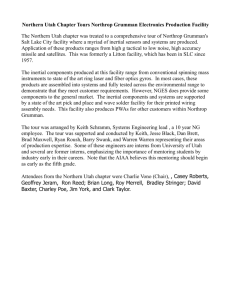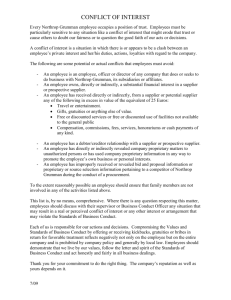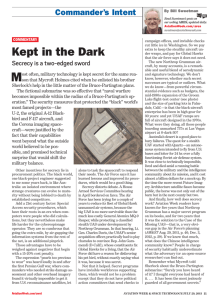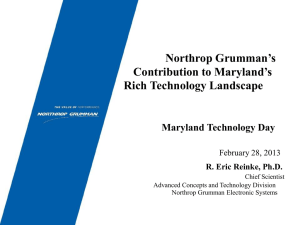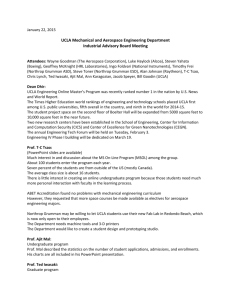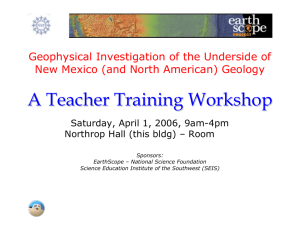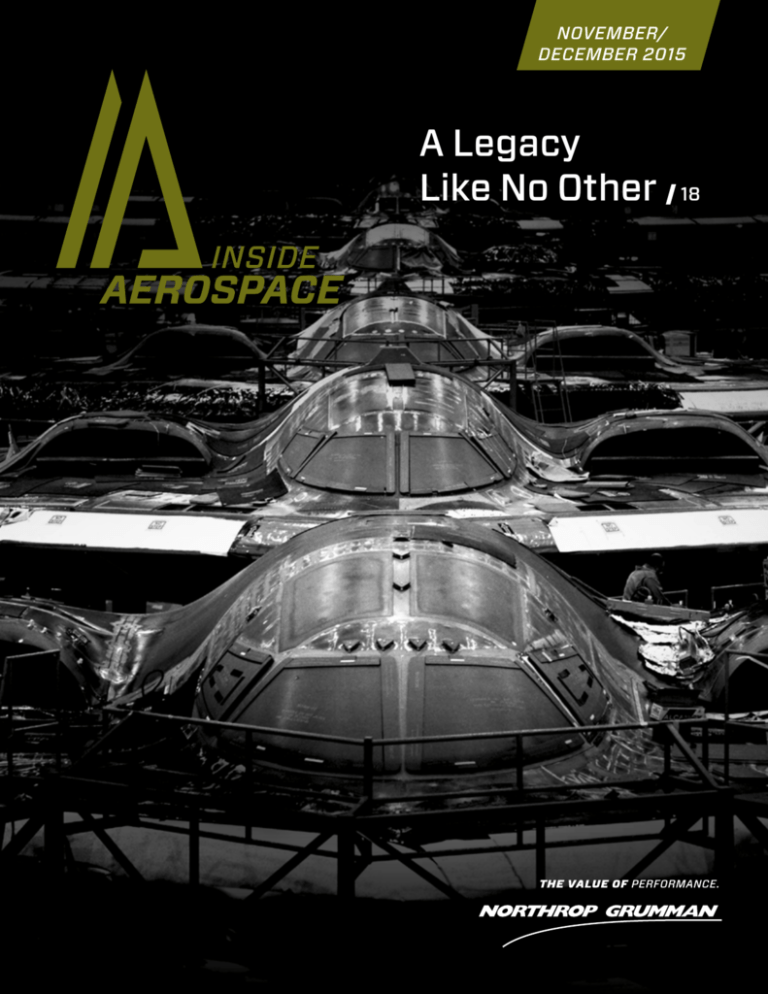
NOVEMBER/
DECEMBER 2015
A Legacy
Like No Other
18
FUTURE
WHEN THE WORLD CALLS FOR THE
©2015 Northrop Grumman Corporation
PERSPECTIVES
OUR YEAR
CONTENTS
5
PERSPECTIVES
6
HEADLINES
8
HERITAGE
10
PERFORMANCE
18
COVER STORY
A View from Leadership
Northrop Grumman in the News
Milestones in Northrop Grumman History
Products and Program Updates
A Legacy Like No Other
20
INGENUITY IN ACTION
22
ACROSS THE SECTOR
30
COMMUNITY
Our Latest Innovative Solutions
You Make A Difference
COVER STORY
“Our team has the resources in place
to execute this important program,
and we’re ready to get to work.”
—Wes Bush, chairman, chief
executive officer and president
of Northrop Grumman
Palmdale, Calif., home of the legendary B-2
stealth bomber, a key component of the
nation’s long-range strike arsenal and
one of the most survivable aircraft in
the world. Tom Vice
Corporate Vice President and President, Northrop Grumman Aerospace Systems
This has been an incredible year.
I am in awe of what we have
accomplished together. What
began as a year of LIMITLESS
possibilities has concluded as
one of amazing achievements.
We have created a culture that
thrives on innovation, invention
and creativity. Our culture has
fueled our success on so many
levels, in countless domains.
amazing time machine, the
James Webb Space Telescope.
Our Global Hawk team has made
tremendous strides in operational
performance shattering cost
curves in the process, as well as
collecting prestigious accolades
along the way including the
James Roche Sustainment
Award — winning this for a
record third time!
These are historic accomplishments.
We embarked on this journey with
a bold strategy. And, our strategy
is working.
We have ignited new ways of
thinking — initiatives like Busting Bureaucracy, NG NEXT,
and NEST for ourselves, for
our customers, for our future.
We celebrated top industry
honors from Aviation Week’s
Program Excellence awards
for our Protected Satellite
Communications Payloads
Orbital Operations and the
X-47B program teams.
You are an amazingly gifted team.
We have achieved what many
thought impossible.
We have grown globally with
successful captures in Japan
and the Republic of Korea with
franchise programs — the E-2D
Advanced Hawkeye and the
RQ-4 Global Hawk. We received
notification of a sole source
contract for AMP-2, completed
the operational assessment of
the MQ-8C Fire Scout, won two
contracts in directed energy
and demonstrated autonomous
aerial refueling with an unmanned
system — the incredible X-47B
unmanned combat air system.
We made great progress across
our broad space portfolio —
making advances in Advanced
EHF and remaining on track for
a 2018 launch for the world’s
We are leaders — number one in
Space, number one in Unmanned
Systems and number two in Manned
Aircraft. And we are continuing to
innovate and invest for export to
expand our global operations.
And think about this, we’ve only
just begun.
We are shaping wins for the
Joint STARS recapitalization,
unmanned carrier-based strike
system, and the Trainer-X
programs, and launching
new captures for the U.S. Air
Force’s and U.S. Navy’s next
generation fighters.
Our investment in basic and
applied research will drive new
technology advancements for
future systems.
And, we won the contract for the
nation’s critical new Long-Range
Strike Bomber.
INSIDE AEROSPACE
NOVEMBER/DECEMBER 2015
5
32
HEADLINES
Protected Satcom,
UCAS-D Win Aviation
Week Awards
Sector Vice President, Communications
Cynthia Curiel
Director, Enterprise Communications
Cyndi Wegerbauer
Manager, Employee Communications
Ann Akutagawa
Executive Editor
Kathy Ford
Managing Editor
Linda Javier
Creative Director
Adam Ugolnik
Art Director
Antoinette Bing Zaté
Advertising Director
Darrell Brock
Contributors
Ann Carney, Tom Henson, Linda Javier,
Sally Koris, Brooks McKinney, TJ Ortega,
Bonnie Poindexter, Alan Radecki,
Celina Ramirez, Mark Root
Editorial Board
Jessica Burtness, Alex Evers, Steve Fisher,
Kathy Ford, Linda Javier, Sally Koris,
Christina Thompson, Katherine Thompson,
Adam Ugolnik, Antoinette Bing Zaté
Inside Aerospace magazine is published
for employees by Aerospace Systems
Communications. Archives are available
on the intranet. Please contact Kathy Ford
(kathleen.ford@ngc.com) for permission to
reprint, excerpt material, request additional
copies, or to provide story ideas.
All photography courtesy of Northrop Grumman
unless otherwise indicated.
Inside Aerospace
© 2015 Northrop Grumman Corporation
All Rights Reserved. Printed in USA
6
32
The Palmdale Aircraft Integration Center of Excellence is the first aerospace
manufacturer in the country to be a certified Zero Waste facility.
Dr. Sudhakar Rao wears the Professor S.N. Mitra memorial medal presented to him in
India for his pioneering work in multi-beam payload technology.
Photo by Alan Radecki
Photo by Alex Evers
Palmdale First Zero
Waste Facility
Being the first in the nation to
reach a goal designed to help
the environment is quite an
achievement. And that lofty
challenge was recently met by
the Palmdale Aircraft Integration
Center of Excellence (CoE).
In September, the CoE was
recognized at a ceremony by
the United States Zero Waste
Business Council for being the
first aerospace manufacturer in
the country to be a certified Zero
Waste facility. By diverting 90
percent of its waste from landfill,
incineration and the environment,
the CoE took a strong stand and
set an outstanding example.
Local public officials and media
joined Palmdale, Calif., employees at the ceremony, where
Andy Reynolds, vice president,
Manufacturing Operations and
Palmdale site manager, was
presented the Silver Zero
Waste certification and plaque.
In accepting the award, Reynolds
remarked, “We want to be good
stewards of the environment.
We realize the importance of that
opportunity and responsibility.”
INSIDE AEROSPACE
“Northrop Grumman is a great
example of what type of impact
we can make,” said Palmdale City
Mayor Jim Ledford, “not only in
our own neighborhoods, but for
the environment.”
— Celina Ramirez
Rao Receives India’s
Top Technology Award
Dr. Sudhakar Rao, Northrop
Grumman Fellow in Engineering’s Electronics and Payloads
directorate, was honored in
September by the Institution of
Electronics and Telecommunication Engineers (IETE), India’s
top professional society for
the advancement of science
and technology in electronics,
telecommunication and information technology.
Dr. Rao received IETE’s prestigious
Professor S.N. Mitra Memorial
Award for his pioneering work
throughout his career in multibeam payload technology using
high gain multiple spot beams
for military and commercial
communications satellites.
Dr. Rao’s design, analysis and
development methods power
more than 65 communications
satellites in use worldwide,
including high capacity satellites
NOVEMBER/DECEMBER 2015
with more than 100 GHz capacity
for personal communications.
of the Society of Women Engineers
(SWE) held in Nashville, Tenn.
“This is the best and most
meaningful award among those
I’ve received,” said Dr. Rao. “It
was wonderful to have my wife
by my side as I was honored in
my birth country. It was also very
special to reunite with classmates
and inspiring professors whom I
have not seen in 40 years since
relocating to the United States.”
SWE awards recognize individuals
who enhance the engineering
profession through contributions
to industry, education and the
community.
An originator and master innovator, Dr. Rao holds 44 U.S. patents
related to satellite antennas,
payloads and high-power test
methods and has published
165 technical papers and three
textbooks on his expertise. From
television viewers and Internet
users to soldiers on the battlefield,
people around the world directly
benefit from Dr. Rao’s technical
innovations.
— Bonnie Poindexter
Petryszyn, Medalle
Honored at SWE
Conference
Two Northrop Grumman leaders,
Mary Petryszyn and Katherine
Medalle received awards in
October at the annual conference
Petryszyn, Aerospace Systems
vice president, global strategy
and mission solutions, received
the Global Leadership Award
for outstanding contributions
in engineering and technical
management in an international setting.
A fellow life member of SWE,
Petryszyn serves on the SWE
Corporate Partnership Council.
In 2005, she received the SWE
Upward Mobility Award for her
contributions to the engineering field.
Medalle, Electronic Systems
director of airborne tactical
sensors product support,
received an Emerging Leader
award for her active engagement
in engineering and outstanding
technical accomplishments. She
is responsible for international
and domestic customer support
and sustainment of a Northrop
Grumman sensor providing mission
critical support to customers.
— Mark Root
Two Northrop Grumman
programs—Protected Satellite
Communications Payloads
Orbital Operations and Unmanned
Combat Air System Demonstrator
(UCAS-D)—received Program
Excellence awards from Aviation
Week in November. The awards
celebrate the “best of the best
programs” that are delivering
results and finding new ways to
be more innovative, efficient
and better at delivering value
to customers.
Northrop Grumman has built
and sustained protected satellite
communication payloads for more
than 21 years. Collectively, the
payloads have provided more
than 750,000 hours of service
with more than 99 percent
availability in operational service.
The program is led by Peggy Paul,
the first program manager in
the history of the Aviation Week
Program Excellence Awards to win
twice. The magazine recognized
Paul and the Defense Support
Program team in 2007.
The U.S. Navy UCAS-D/Northrop
Grumman team, led by program
manager Pablo Gonzalez, won
for performing the first ever
autonomous aerial refueling of an
unmanned aircraft demonstrating
the system’s capability of extended
range and endurance.
— Sally Koris and TJ Ortega
7
32
HERITAGE
1943
By Alan Radecki
A LOOK BACK AT GRUMMAN ON LONG ISLAND
President and CEO Wes Bush
recently announced Northrop
Grumman’s realignment of its
operating sectors, which will
move the legacy Grumman facility
at Bethpage, Long Island, N.Y.,
from Aerospace Systems to the
new Mission Systems sector in
early 2016. Inside Aerospace would
like to pay tribute to the legacy of
these sites.
Although the Long Island presence
of Grumman started at the beginning of 1930, the company hit
its stride during World War II
when a number of additional
plants opened to handle the
wartime workload.
A 1940’s aerial view looking northwest at the Grumman Bethpage airfield.
Photo courtesy of Paul Freeman, www.airfields-freeman.com
This set of color images from a 1943 Grumman calendar
gives a rare glimpse into what it looked like during the
peak of Grumman’s wartime production.
32
April 1937 saw Grumman, which had
grown to 350 employees, arrive at its
new home in Bethpage, Long Island,
with the opening of Plant 1. Many
of Grumman’s legendary aircraft,
starting with the F-4F Wildcat, were
born at this Bethpage plant.
The Babylon plant produced the
wiring harnesses used in all of
Grumman’s aircraft. The original
caption for this photo reads, “A
hundred women set up the electric wires for Grumman planes. They
plot the path of every electric impulse right up to the trigger-switch.
They are truly the women behind
the man behind the gun.”
Grumman’s success led to rapid
growth and the need for a bigger
facility, and the abandoned Curtiss
Airport at Valley Stream was ideal.
Here, Grumman’s first retractable
gear fighter, the JJ-1, was born.
8
THREE CENTS
The Amityville Plant 12 was home to
the Grumman War Production Corps
and specialized in parts to support
the production of the F-4F Wildcat
fighter.
INSIDE AEROSPACE
NOVEMBER/DECEMBER 2015
9
32
IT’S IOC FOR
AEHF
By Sally Koris
The announcement by U.S. Air Force
General John E. Hyten, Commander of
Air Force Space Command, in July that
the Advanced Extremely High Frequency
(AEHF) satellite system had achieved
Initial Operational Capability (IOC) marked
the culmination of years of hard work
by employees throughout the sector to
deliver a new capability to the warfighter.
The AEHF Flight 3 satellite being
encapsulated for placement atop an
Atlas V launch vehicle.
Photo courtesy of Lockheed Martin
Word spread quickly among the
hundreds of employees on AEHF
who are building the payloads
and associated systems as well
as among the alumni of Milstar,
its predecessor program and
earlier programs that built the
sector’s MILSATCOM heritage
and capabilities.
“Drawing on two generations of
Milstar expertise, developing
10
32
AEHF payloads has had a profound impact on the sector,” said
Peggy Paul, director, Protected
Satcom Orbital Operations. “It’s
helped to build our unique skills
and technology base, created
a cadre of leadership that has
strengthened the sector and
the company, produced valuable
intellectual property and patents,
and contributed to the company’s
financial returns.”
AEHF delivers the critical strategic
and tactical information to the
National Command Authority
and the Air Force, Army, Navy,
Marines and several allied nations.
The system delivers the flexible
connectivity-on-demand needed to
achieve swift, decisive outcomes
based on information dominance.
The company produces the
Extended Data Rate (XDR)
payloads on AEHF in addition to
the Low Data Rate and Medium
Data Rate payloads on AEHF and
its predecessor system, Milstar,
for prime contractor Lockheed
Martin. Each AEHF payload
consists of processor hardware
and software, antennas, radio
frequency subsystems and
crosslinks. The payload provides up
to 10 times greater capacity than
its predecessor Milstar II and channel data rates six times higher.
Achieving IOC means the AEHF
system demonstrated that it meets
its requirements—transmitting
critical information, text, voice,
video, maps and other strategic
and tactical data to users
PERFORMANCE
worldwide with communications
that are protected against enemy
jamming, spoofing, detection
and interception.
Complex tasks had to be performed leading up to IOC: AEHF
satellites had to be designed,
built and launched; the satellites
had to be integrated with, and
fully backward compatible with
the existing Milstar system; the
mission control element had to be
upgraded to handle XDR data; and
fixed and mobile terminals had to
be modified or built to handle the
new XDR capability.
“AEHF is the most advanced and
complex communication payload
in the world and provides U.S.
national and defense leaders
assured communications day
or night, without detection or
interception under any level of
military conflict,” said Tim Frei,
vice president, Communication
Systems.
“It took the work
of a committed and
talented government
and industry team
to bring AEHF to
IOC. We are proud
of our contributions
to this system.”
waveform design, and onboard
software-based communication
networks.
/ Innovative approaches were
developed for building and
operating the payloads using
high fidelity engineering test
beds to realize cost, schedule
and risk reduction benefits
throughout the program’s
life cycle.
/ Engineering and software experts
continue to provide support to
operational users, leveraging
highly specialized skills devel oped during design, production
and ground test.
/ The team made technical
advances and innovations
across the company’s portfolio
and industry that have enabled
the sector to expand into
adjacent business areas,
such as Low Cost Terminals,
Enhanced Polar System
payloads, and several
restricted programs.
/ Awards in recognition of
achievements have been
received from sector,
company and external
organizations.
/ The most knowledgeable
personnel from Milstar were
used, with direct experience in
the development, ground test
and operations of the payloads,
to help with the ongoing AEHF
payload production effort.
/ All four payloads were delivered
early, before their scheduled
delivery date.
Four AEHF payloads have been
delivered and two more are
well into production. Among
the many accomplishments
on the AEHF program:
/ New capabilities were
established for space-based
signal and data processors,
low-noise high frequency
electronics, 60 GHz crosslinks,
phased array antennas,
protected communications
INSIDE AEROSPACE
NOVEMBER/DECEMBER 2015
11
32
PERFORMANCE
OKLAHOMA
KEEPS THE B-2 OK
By Brooks McKinney
In July, Aerospace Systems used a B-2 bomber
flight demonstration at Edwards Air Force Base
to highlight Northrop Grumman’s leadership in a
new U.S. Air Force architectural standard called
Open Mission Systems (OMS).
Underpinning that success was a
concentrated effort by the sector’s
B-2 team in Oklahoma City. In
just six weeks, they developed,
integrated, tested and delivered
to Edwards Air Force Base (AFB) a
stand-alone subsystem that would
allow the B-2 to communicate with
other OMS-compliant systems. In
the past, such an engineering task
would have taken many months, if
not years, to achieve.
powerful, most revered weapon
system in the nation’s long-range
strike inventory.”
“The successful B-2 OMS flight
tests proved two important things
about our company,” said Pat
McMahon, sector vice president
and general manager, Military
Aircraft Systems. “One, that we’re
well positioned to develop and help
deploy OMS-compliant systems on
both legacy and future systems;
and two, that our Oklahoma City
employees play a pivotal role in the
success of the B-2 as the most
The team provides engineering
and support services for B-2
sustainment and modernization.
Its sustainment tasks include
hardware and software sustaining
engineering—helping the Air Force
troubleshoot hardware or software
glitches on the jet, managing
inventories of consumable materials used to maintain the B-2,
and helping identify and acquire
adequate stores of replacement
12
32
Aerospace Systems’ presence
in Oklahoma City comprises
approximately 350 employees,
all of them supporting B-2, spread
across 255,000 square feet of
office, engineering and laboratory
space in facilities on or near
Tinker AFB.
The Autonomy Challenge winning team.
Photo by Dave Buchanan
parts for B-2 avionics that have
become obsolete.
integration and testing of new
avionics subsystems.
“We work closely with our U.S.
government counterparts at Tinker
to manage and help resolve the
logistic challenges of sustaining
a low density, high demand fleet
of 25-year-old aircraft,” said Mark
Johnson, Aerospace Systems’
director of B-2 product support.
The WSSC includes facilities that
duplicate the characteristics and
operational behavior of the jet—
among them a full motion B-2 flight
simulator, a mock B-2 weapons bay
and a full scale mock-up of the B-2
hydraulic flight control system.
Oklahoma City is also the gateway
to B-2 modernization. Every new
capability proposed for the jet
begins life in a government facility
at Tinker called the Weapon
Systems Support Center (WSSC).
There, in a series of laboratories,
Aerospace Systems employees
pursue B-2 engineering activities
such as software development,
defining and testing new ways to
deliver weapons, and complete
“In the WSSC, we stage, integrate
and test all of the software and
hardware required for every
proposed B-2 upgrade,” explains
Ron Naylor, Aerospace Systems’
Oklahoma site lead and director of
B-2 modernization. “Our integration process includes rigorous
hardware/software compatibility
testing, functional testing, and a
thorough government vetting and
certification process. Only then is
each upgrade formally released
and delivered to Edwards AFB for
flight testing.”
Oklahoma City employees are
invested not only in the future of
the B-2, but also in the future of the
company and their community.
“The aerospace community in
Oklahoma City is small, but very
tight-knit,” says Naylor. “Through
Connect1NG, our employees support
both urgent and ongoing community
needs. They’re as likely to be found
helping provide disaster relief after
a tornado or wildfire, as delivering
supplies to a women’s shelter,
running a blood drive, or manning
an aid station at the Oklahoma
City Marathon.”
Oklahoma City employees can
also be found at home working
on Northrop Grumman’s “next
big thing.” In October 2014, and
again in April 2015, a team of local
engineers—Steven Adams, Matt
Blair, Zachary Dennis, and Jeremy
INSIDE AEROSPACE
Lakes—took top honors in the
sector’s Autonomy Challenge, an
engineering competition designed
to develop software algorithms
for fleets of autonomous iRobots
engaged in missions of interest
to Northrop Grumman and its
customers.
“I’m proud of all the
things our Oklahoma
City employees
have achieved by
partnering with our
U.S. government
stakeholders,” adds
Naylor. “The team is
doing amazing work,
both in the community
and around the world.
NOVEMBER/DECEMBER 2015
13
32
PERFORMANCE
THE
CHOICE
IS YOURS
By Bonnie Poindexter
What better way to select top performers than by
asking employees themselves to choose individuals
on their teams who are demonstrating the best of
the best.
That’s what the Engineers Choice
Awards is all about.
Engineering and Global Product
Development’s (E&GPD) peerrecognition program identifies
and celebrates individual engineering employees as well as
engineering teams for exemplary technical accomplishments
and demonstration of leadership, innovation, affordability,
collaboration and execution
of key objectives.
“Game changers” is how Stuart
Linsky, sector vice president,
Engineering and Global Product Development, described
Aerospace Systems engineers in
his opening remarks as host of the
company’s third annual Engineers
Choice Awards luncheon held in
November in Marina del Rey, Calif.
“The work we do in engineering
helps preserve freedom. People’s
lives depend on our performance,”
said Linsky. “That is an incredible
responsibility in which we all
take great pride. The Engineers
Choice Awards recognize our
employees’ exemplary engineering
performance, often demonstrated
under great challenge and with
high levels of scrutiny.”
Linsky recognized 39 winners with
trophies and special prizes during
the luncheon. Attendees spent
valuable time networking with
sector and Engineering leadership.
So, how do you earn an Engineers
Choice Award?
E&GPD employees nominate
individuals and/or teams in a
variety of award categories within
each Engineering directorate
in July. Engineering leadership,
including Distinguished Technical
Leaders and Chief Engineers,
review the submissions and
select up to three finalists in each
category. Finalists are announced
and E&GPD employees vote online
to determine the winners.
This year, close to 600 engineering employees were nominated
for 28 awards in seven different
categories and the competition
was fierce. In all, close to 7,500
votes were cast to determine
this year’s winners, a 32 percent
increase over last year.
As recent program wins continue
to create many new engineering
career opportunities within the
sector, the annual peer-recognition program highlights employee
development while celebrating
some of the top engineering work
performed in the organization.
“
From enabling fundamental scientific
advancements in R&D to implementing disruptive
design and manufacturing capabilities to win new
business, Aerospace Systems’ Engineering team
generates game-changing results worthy
of recognition and celebration.
”
—Stuart Linsky
sector vice president, Engineering and Global Product Development
2015 Engineers Choice Award winners join Stuart Linksy
for a groupie following the award ceremony.
Photo by Robert M. Brown
14
32
INSIDE AEROSPACE
NOVEMBER/DECEMBER 2015
15
32
Hidehisa Horinouchi, Consul General of Japan,
Los Angeles (left) and Chikara Komiyama, Consul for
Defense Affairs and Security Attaché, Los Angeles,
represented Japan in the ceremonial delivery of the
AX-5 center fuselage.
Photo by Alan Radecki
PERFORMANCE
CENTER FUSELAGE COMPLETED
FOR FIRST JAPANESE-BUILT F-35
By Brooks McKinney
In late September, Aerospace
Systems completed the center
fuselage for the first F-35 Joint
Strike Fighter that Japan will
produce in its new F-35A final
assembly and checkout facility
in Nagoya, Japan.
That center fuselage, designated
AX-5, was presented in early
October to representatives
of the Japanese government
and Lockheed Martin, the F-35
prime contractor, during a brief
ceremony at the Palmdale Aircraft
Integration Center of Excellence.
As part of the visit, the guests
received a tour of the F-35
Integrated Assembly Line, where
the sector will produce all center
fuselages for Japan.
“It’s fitting that today’s delivery
coincides with Manufacturing
Day, a national celebration of our
country’s manufacturing skills
16
32
and capabilities,” said David Tracy,
director of Aerospace Systems
F-35 center fuselage integrated
product team.
“another phase of enhancing the
U.S./Japanese security alliance,”
calling it “a centerpiece of Japan’s
effort to assemble its first F-35.”
“We’re proud of the
manufacturing leadership that Northrop
Grumman brings to
the F-35 program as
we continue to increase
the quality, affordability
and production rate of
the center fuselage.”
“The F-35 program is really a
team sport,” said Joel Malone,
Lockheed Martin’s F-35 business
development manager for Japan,
“And Japan has been an incredible
F-35 customer.” He also thanked
Northrop Grumman for its role in
helping build customer confidence
that every F-35 will be delivered
on time, on cost with the promised
performance.
Hidehisa Horinouchi, Consul
General of Japan, Los Angeles,
spoke during the ceremony of the
growing cooperation between U.S.
and Japanese defense forces. He
described the delivery of AX-5 as
INSIDE AEROSPACE
AX-5 is one of 42 center fuselages that Northrop Grumman will
produce for Japan. It is the 207th
center fuselage that the company
has produced in Palmdale, Calif.,
and one of more than 3,000
that will be produced for the
F-35 program.
NOVEMBER/DECEMBER 2015
WHEN YOU HAVE 35 YEARS
OF EXPERIENCE BUILDING
STEALTH BOMBERS, YOU’RE
INHERENTLY MORE AFFORDABLE.
With over 35 years of experience manufacturing stealth bombers, Northrop Grumman’s
Long Range Strike Bomber is inherently more affordable. Our innovative approach
combines a mature design with our award-winning integrated assembly line for maximum
efficiency. And because we also make the key avionics and stealth components for other
advanced aircraft, we can deliver better-produced stealth systems.
THIS IS WHAT WE DO. AGAIN.
© 2015 Northrop Grumman Corporation
w w w . A m e r i c a s N e w B o m b e r. c o m
COVER STORY
Wes Bush celebrates
Northrop Grumman’s big win with
employees on the West Coast.
Photo by Alyssa Cooper
“Our team has the resources in place
to execute this important program,
and we’re ready to get to work.”
—Wes Bush, chairman, chief executive officer and president
of Northrop Grumman
A
LEGACY
By Ann Carney
18
32
LIKE NO OTHER
Thirty-five years ago, Northrop
Grumman put its passion for innovation and customer satisfaction
to work designing and producing
the B-2, an aircraft unlike the world
had ever seen, for a mission that
would redefine the ground rules
and boundaries of global air power.
Today, the company is applying that
spirit of innovation again, this time
to helping the nation define and
deploy the next generation of
global deterrence.
Bush, chairman, chief executive
officer and president of Northrop
Grumman. Employees heard
from senior leadership that bold
ingenuity and years of hard work
and unprecedented strategic
planning had paid off: Northrop
Grumman will build the nation’s
next stealth bomber.
On Nov. 9, applauding and waving
miniature American flags, 700
employees welcomed Tom Vice,
corporate vice president and sector
president, Aerospace Systems, and
several state and local leaders to
the hangar stage at the Manned
Aircraft Design Center of Excellence in Melbourne, Fla.
The purpose of this event, and
several others held across the
country, was to thank and celebrate with employees who helped
to make the selection of Northrop
Grumman for the U.S. Air Force’s
Long-Range Strike Bomber program a reality.
Three hours after the Melbourne
event, another 700 employees in
Palmdale, Calif., joined together
to enthusiastically greet Wes
And in Baltimore, Md., more than
1,000 employees at the Northrop
Grumman Electronic Systems
facility gathered to hear from
sector president Gloria Flach and
leaders from the region on the
impact this program will have on
Northrop Grumman and the nation.
The high level of enthusiasm
and comradery was evident
as dignitaries attended these
celebrations in force. In Melbourne,
guest speakers included Florida
Gov. Rick Scott, Sen. Bill Nelson and
U.S. Rep. Bill Posey. In Palmdale,
U.S. Rep. Mac Thornberry, chairman of the House Armed Services
Committee, and U.S. Rep. Steve
Knight joined Wes Bush in
congratulating employees and
remarking on the company’s
impressive history that made
this military milestone possible.
In Baltimore, Congressman “Dutch”
Ruppersberger, Congressman
John Sarbanes and Congressman
Elijah Cummings shared their deep
appreciation for what our employees
do every day to help keep our warfighters safe from harm.
With more than 35 years of
experience in advanced stealth
technology, Northrop Grumman is
the only company that has designed,
developed and delivered a longrange stealth bomber. That’s quite
an accomplishment and a defining
fact that led to Northrop Grumman’s
selection. Tom Vice told the crowd,
“The only ones who were
surprised that we won is
the team that has never
done this before.”
These employee events were
much more than celebrations—
they were statements. Statements
about how Northrop Grumman
employees consistently approach
their jobs with creativity, scrutiny
and expertise. And statements that
showcased Northrop Grumman
as an exceptional, strong industry
leader and a powerful innovator that
is taking command of its future.
Brooks McKinney also contributed to
this article.
Tom Vice addresses employees
at Melbourne rally celebration.
Photo by Steve Potter
INSIDE AEROSPACE
NOVEMBER/DECEMBER 2015
19
32
INGENUITY
ONE FLEET
By Alan Radecki
“The more we can do with the
Global Hawk, the better off our
country will be.”
—Phil Lo
When Ryan Aeronautical created the original
RQ-4A Global Hawk in the 1990s, it was
designed around specific sensors. It was
so successful that its potential for carrying
payloads for other missions was quickly
recognized.
However, the airframe had to
be partially redesigned each
time a new sensor package was
developed. This resulted in various
Global Hawk versions, commonly
known as “Blocks.”
This design approach meant
that payloads, as a permanent
part of the aircraft, were not
interchangeable. For instance,
when NASA acquired two of the
original Block 0 airframes from
the U.S. Air Force, it took months
to modify it to carry weatherscience payloads.
As sensor technology evolved and
new Global Hawk missions were
identified, a universal payload
adaptor was now mandatory to
meet warfighters’ requirements.
“We needed to reconfigure our
aircraft in a much more affordable
and easier way,” said Alfredo
Ramirez, director and High Altitude Long Endurance (HALE)
chief architect.
Pondering this challenge, a
moment of ingenuity came
to Phil Lo, HALE configuration
design engineer, as he glanced at
tabletops in the Rancho Bernardo,
Calif., laser lab. The surfaces of
these lab benches have a matrix
of threaded holes needed to
mount test equipment in versatile
configurations. “That was the
genius of it,” he explained. “Our
team got together, thought it over,
and asked how we could duplicate
this onto the Global Hawk.”
creativity, enthusiasm and all the
tools you have in solving a very
complex problem.”
Lo’s team innovated a set of small
fittings, each about the size and
shape of a hockey puck, that are
attached to the bottom of the
aircraft in a grid pattern, along
with a large plate mounted to
the various payloads. The system
was named the Universal Payload
Adaptor, or UPA, and it is making it
possible to change Global Hawk’s
“blocks” into One Fleet, where any
Global Hawk can carry any sensor.
Ramirez agrees, “When you can
solve complex problems with
simple solutions … that’s a
great feeling.”
“The concept of the UPA is simple,”
says Lo, “But what’s remarkable is
the execution of the design—using
The UPA provides a rapid swap
out of payloads, some types
of which have yet to even be
theorized. In parallel with the
UPA, HALE engineers are
developing an open architecture system that addresses the
payload’s functionality, allowing
a “plug-and-play” payload system.
Consider this: with the UPA
and an open architecture
system, a universal Global
Hawk might fly a SIGINT
payload over hostile territory one day—and a
humanitarian search-andrescue sensor package over
a natural disaster the next.
For Phil Lo, the issue was
more than just solving a
technical problem; it was
contributing to the greater
cause.
The result is an unblocking of
the Blocks.
Phil Lo and the heart of the Universal Payload Adaptor,
which will enable a much wider range of payloads to be
interchangeably carried on the “unblocked” Global Hawks.
Photo by Alan Radecki
20
32
INSIDE AEROSPACE
NOVEMBER/DECEMBER 2015
21
32
WISE:
THE NEXT GENERATION By Ann Carney
ACROSS THE SECTOR
“Women engineers demonstrate every day that they have
the ability to excel in challenging fields such as science and
aerospace. Greater networking opportunities with senior
management will strengthen their potential for discovery
and advancement.”
—Wendy Robello, manager of Engineering Competitive Analysis
worked with executive sponsors
and WIL alumna mentors to tackle
six different business challenges.
The teams’ hard work and research culminated this past
June when the 30-member group
came together from across the
nation to present its solutions
at the inaugural WISE Summit
in Redondo Beach, Calif.
Wendy Robello, manager of
Engineering Competitive Analysis, was one of the protégées
participating at the summit.
Her team researched avenues
of retention and advancement
for women in mid-level technical
positions within the company.
As the first generation and first
female in her family to attend
college, Robello was ideally suited to embrace this topic.
Richa Jolly shares thoughts with guest
speaker during WISE Summit Q&A.
Photos by Daniel Perales
22
Women who excel in science
and engineering needed more
opportunities to glean leadership
skills that would help them grow
and advance in their field. That’s
why Northrop Grumman Aerospace
Systems established Women in
Science and Engineering (WISE)
earlier this year.
“We wanted to create a support
network, strongly linked to the
corporate Women in Leadership
32
(WIL) program, that would foster
professional relationships with
senior management and also lead
to sponsorship opportunities,”
said Karen Tokashiki, director of
Integration, Competitive Analysis
and Materials for Engineering and
Global Product Development.
WISE members were selected,
assigned executive mentors, and
divided into six teams. Over the
following three months, teams
“I’ve always enjoyed math,” said
Robello. “But I never thought
about pursuing it with relation to
a career. The idea of college was
not promoted in my family growing
up. Once I was introduced to physics, I loved the challenge. It was
tough at first, but then it clicked. I
wanted to find a way to integrate
mathematics and physics without
losing my artistic/creative side.”
Robello, who earned a bachelor’s
degree in mechanical engineering
and a master’s in systems architecture and engineering, said that
might not have happened if not for
the encouragement of mentors
along the way.
“One of the themes throughout
our [team’s] research was that
in addition to high performance,
quality mentorships and networking are vital for career growth,”
she said.
Recommendations presented by
Robello’s team included developing a chief engineer pilot program
and holding quarterly virtual panel
discussions led by women with
high-level technical positions at
Northrop Grumman.
Chris Daughters, vice president
of Engineering and Advanced
Development for Special Programs
in El Segundo, Calif., advised
Robello’s team and served as a
mentor to one of its members.
He noted that in many companies,
diversity statistics are satisfactory
for entry-level female engineers
but sharply decline once women
approach 10 years of experience.
“Programs like WIL and WISE are a
positive step in realizing diversity in
the next generation of our technical
leaders, and there are more steps
we could take,” he said.
“Diversity at all levels is essential
for Northrop Grumman because
it makes us a more valuable
company, with more ingenuity,
stronger teams, superior products,
and better relationships with our
customers.”
INSIDE AEROSPACE
Wendy Robello (left) with Halle Horne
during their team’s presentation.
NOVEMBER/DECEMBER 2015
23
32
ONE
ACROSS THE SECTOR
MILLION
HOURS SAVED
By Tom Henson
As it approached its goal of helping save one million
hours of work in 2015, the Busting Bureaucracy
initiative recently paused long enough to mark
one year of success.
Besides the significant savings,
the program’s website (accessed
by typing ‘busting’ in the browser
window) has logged more than
30,000 visits and 400 ideas
for improvements. Employees
have viewed the ideas more than
100,000 times, often offering
suggestions and solutions. And,
most encouraging of all, a recent
snapshot indicated that 90
percent of ideas were coming
from first-time submitters.
The numbers alone are worth
celebrating and indicate ongoing and increasing interest in
the program among employees.
But numbers only tell part of the
success story; it’s the news behind the numbers that has made
this a remarkable year.
24
32
Working together across functions,
the Busting Bureaucracy team
and volunteers from around the
sector have achieved high-profile,
high-impact results, including
eliminating the requirement
for a pre-travel approval form;
shifting from a paper, event-driven
photo permission form to a onetime, online, clickable form; and
streamlining purchasing processes
across the sector. These and other
“busted” issues led to a President’s
Award for the program in August
and have demonstrated the value
of finding ways to save time.
“When Busting Bureaucracy
launched in late 2014, everyone
involved understood that taking on
something this ambitious would
be met with some skepticism and
would prove to be a real challenge,”
says Sandy McElroy, lead of the
initiative and director of Sector
Affordability and Business Process
Excellence. “And here we are, one
eventful, inspiring year and we’ve
already seen a real benefit—
helping our teammates find time
to do what they came here to do.”
A perfect example is Jon Linch, an
aeroacoustic engineer responsible for implementing new stealth
technologies that facilitate aircraft survivability. Linch works in
research and development, so he
often purchases unusual, one-off
materials. For this, he’d been using
EPS, a program more suited for
purchases of conventional flight
hardware that required additional
hours and personnel to use.
(left to right): Kyle Rahrig, Jon Linch and David Schein, members of
the aeroacoustics team, with some of their flight-test hardware.
Photo by Glen Sakaguchi
This caused delays for Linch and
additional work for purchasers. He
visited the Busting Bureaucracy
website and submitted the idea to
move his purchases from EPS to a
corporate purchasing card, which
makes ordering his items more like
using an online retail store. Linch
has used his saved hours to draft
and submit four new patents. And,
his work on two projects earned
him nominations for two Engineers
Choice “Invention of the Year”
awards this year.
“Engineering is an
iterative process,
and the purchasing
change shortens that
process considerably,”
said Linch. “Now, I can
bring new ideas from
concept to completion
more rapidly. Most
importantly, I’m able
to do what I’ve always
wanted to do as an
engineer—inspire
and create.”
“Saving time certainly is our
goal, but our main objective is to
enable our incredible teammates
to achieve their own ambitions,”
McElroy says. “Imagine what this
talented work force can do with
extra hours to innovate. We can’t
wait to see what happens next year
and beyond.”
Now McElroy and the Busting
Bureaucracy team are turning
their attention to 2016, and an
even more ambitious timesaving
target, with a new focus on sharing
the benefits of reclaiming lost time
as Linch and others have done.
INSIDE AEROSPACE
NOVEMBER/DECEMBER 2015
25
32
ACROSS THE SECTOR
A
SILVER
&GOLD
to work on many critical programs
and activities, classified and unclassified. From administrative
assistants to engineers, from
flight test to fleet support, their
work has contributed to the
success of the company.
TRIBUTE
By Linda Javier
Service anniversaries may not seem important,
or even reachable, until you hit one.
And then it’s time for celebration!
This year alone, more than 300
employees on the West Coast
and East Coast celebrated their
25-year milestone.
On Nov. 7 at the Beverly Hills
Hotel in Southern California, 180
Northrop Grumman West Coast
employees were honored for
reaching their 25-year service
anniversary with the company
this year. Celebrating their
amazing 50th anniversary with
the company were Ann Clark,
Frank Fendell and Ann Linen.
After a welcome and introduction
by Heidi Hendrix, sector vice
26
32
president of Human Resources,
Sector President Tom Vice shared
his memory of his first day on
the job: “a seemingly indefinite
clearance process followed by
a walk through a series of doors
reminiscent of the opening
sequence to the show Get Smart.”
Then, seeing a mockup of an
aircraft so sleek that didn’t look like
anything he had ever seen before,
he realized that “this was going to
be a really cool job.” His first day
was on the B-2.
Acknowledging where we’ve been
and where we came from, Vice
lauded the company’s founders,
dreamers, and innovators.
INSIDE AEROSPACE
“You have sacrificed a lot, but for
a good and honorable cause—we
build systems that take men and
women in harm’s way to protect
and project freedom and bring
them back home. We have put
Americans on the moon, and we
intend to be the team that builds
systems that find habitable
planets around distant stars,”
Vice said. “To you, the spouses,
the partners, and the families, I
want to say Thank You.”
Looking back, 50-year honoree
Ann Linen, administrative assistant in San Diego, attributes her
longevity with the company to
“management and the fantastic
people I work with.” She started
with Ryan Aerospace and Teledyne
Ryan before becoming part of
Northrop Grumman.
Ann Clark, senior administrative
assistant in Redondo Beach, who
originally joined TRW as a clerk
in 1965, commented “There was
such a variety of opportunities on
various projects and programs
… but remain with the company.”
She later had the opportunity to
work on the Lunar Module Descent
Engine and the James Webb Space
Telescope program.
Fellow 50-year honoree Frank
Fendell, mechanical engineer in
Redondo Beach, says he was drawn
to TRW’s environment that allowed
him to be as good professionally as
he was capable of being. He also
benefitted from the guidance and
support he received from a series
of mentors throughout his career.
His next milestone? Striving for his
next problem-solving to be better
than any he’s done in the past.
“Applied mathematicians never
exhaust the supply of problems,”
he added, “just the lifespan to
tackle them.”
Fifty years of service: (left to right)
Ann Linen, Frank Fendell and Ann Clark.
“We truly believe our
potential is LIMITLESS
—and we are driven
to build insanely great
products.”
In addition to citing new pursuits
that include the new advanced
jet trainer, the next generation of
surveillance aircraft and resilient
satellites, he reflected on Northrop
Grumman being the first to land an
autonomous aircraft on the deck
of a carrier and the first to refuel
an autonomous aircraft in flight.
The honorees in the room that
evening have worked and continue
NOVEMBER/DECEMBER 2015
Celebrating 25 years with Northrop Grumman
in Beverly Hills, Calif.
Photos by Alex Evers
27
32
ACROSS THE SECTOR
KEVIN
CORPORATE LEAD EXECUTIVE, DAYTON, OHIO
BELL
By Linda Javier
After retiring from the U.S. Air
Force in 2005 with 26 years
of acquisition management
experience, Kevin Bell looked for
another opportunity to use his
business management acumen.
It’s exciting to see all the new
technology and capabilities we
bring to our national defense and
security, specifically to the Air
Force. It makes it exciting to
come into work every day.”
He found it with
Northrop Grumman.
Bell’s involvement in the
community, supported in large
extent by his assistant Lynn
Locke, benefits his engagement
with base personnel and local
industry. As president for the
Wright Brothers Regional Chapter
of the National Defense Industrial
Association, Bell meets monthly
with representatives of all major
defense contractors and some
small businesses to develop and
manage programs to support Air
Force customers.
For more than eight years, Bell
represented Northrop Grumman
in the Dayton region in business
development and as a sector lead
for Aerospace Systems, working
closely with the area’s former
corporate lead executive (CLE)
Jay Jabour. When Jabour retired
last year, this position was a
logical transition for Bell.
“I could now represent all four
sectors and the company in a
broader sense,” says Bell. “It all
seemed to fall into place and is a
capstone for me professionally to
serve as CLE in the Dayton area.”
He interacts primarily with Wright
Patterson Air Force Base, the
Air Force Research Laboratory
and the Air Force Life Cycle
Management Center (LCMC).
The B-2 and Global Hawk
programs are billion-dollar
programs managed at the LCMC.
A number of efforts from across
the company’s sectors are also
done here, including technology
development and future captures.
“I might be dealing with an
Aerospace Systems program
one day, an Electronic Systems
program the next, Information
Systems in the afternoon, and I
really get an appreciation more
broadly about the services and
products this company provides.
The association also supports the
area’s USO chapter, STEM and Air
Force training activities, as well as
special nonprofit organizations,
such as Fisher Nightingale House.
This nationwide organization builds
houses on military installations
(two at Wright Patterson) where
families can stay at no charge
while their loved ones receive
longer-term medical attention.
While he considers becoming a
corporate lead executive as the
highlight of his professional career,
Bell deems the pinnacle of his Air
Force career to be his deployment
to Afghanistan in 2004.
“There’s not a lot of opportunity
in the acquisition career field to
deploy into a combat zone,” Bell
says. “I volunteered while I was a
colonel because I wanted more
direct involvement in the war on
terror before retiring from the
Air Force.”
He became an acquisitions/
logistics mentor and advisor to
the U.S. Major General who led the
Joint Office of Military Cooperation
in Kabul, Afghanistan, and served
as mentor to the Afghan general
in charge of the Afghan National
Army (ANA) acquisition command.
From September 2004-February
2005, Bell directed recruiting,
training and establishment of
a 500-man ANA acquisition
command responsible for acquiring
equipment and supplies, including
thousands of Ford Ranger trucks
and four-wheel drive vehicles
for troop transportation. For his
activity in the war zone, Bell was
awarded the Bronze Star.
Dayton holds a special fascination
for Bell as a city with a rich aviation
heritage. “This is the home of the
Wright Brothers,” he states. “Today,
you can visit Huffman Prairie at the
old Patterson Field where Wilbur
and Orville developed and tested
the first practical airplane.
“I used to live on the Air Force
base, run past Huffman Prairie and
think about how much aviation has
changed the world,” reflects Bell.
“Our company provides some of the
most advanced flying
machines ever created,
and we’re here at this
location where it all
started.”
Kevin Bell in front of the
National Museum of the U.S. Air Force
at Wright Patterson Air Force Base.
Photo by Suzanne Bell
28
32
INSIDE AEROSPACE
NOVEMBER/DECEMBER 2015
29
32
EMPLOYEES GIVING BACK
Featuring Northrop Grumman employees sharing their time,
talent and ideas
BUILD-A-BIKE
El Segundo, Calif.
By Tom Henson
Nearly 150 children in military
services outreach programs will
receive new bicycles this holiday
season thanks to the Build-A-Bike
charity competition.
In October, seven teams from the
El Segundo, Calif., site competed
to see which team could build 21
new children’s bikes right out of
the box. The F/A-18 Structures
group won with a completion time
of 13 minutes.
The Build-A-Bike event was a
joint effort with Aerospace
Systems Corporate Citizenship
and the nonprofit, L.A. Works.
More than 250 employees
participated in the event remotely from Redondo Beach,
Palmdale and San Diego.
COMMUNITY
USO CARNIVAL
AND CAR SHOW
Palmdale, Calif.
By Celina Ramirez
Doing good while having fun
summarizes this year’s USO
Carnival and Car Show held in
early September at the Palmdale
Aircraft Integration Center of
Excellence.
From adult tricycle races to the
impressive car and motorcycle
show, from dunk tanks and live
music to a “cupcake war” bakeoff, this 7th annual event was
attended by more than 800
employees.
Mike Schulte (left) and Damien Smith
pose after pedaling away to victory in
the annual USO Trike Race.
Photo by Aaron Lewis
Six teams of employees, with
representatives from both work
shifts, participated in the tricycle
(trike) race, the most anticipated and humorous of the day’s
competitions. Engineers Damien
Smith and Michael Schulte won
the trike race trophy for first shift.
“Damien and I have done the trike
race for at least five or six years
now,” said Schulte. “It’s fun for
us and fun for others to watch, but
most importantly, it raises money
for the USO to support our troops.”
Race requirements include not only
riding a tricycle, but assembling it
beforehand and decorating it with
a creative flair. Additionally, it has
become a tradition for the teams
to dress in costume, enhancing the
playful spirit of the race.
At the end of the day, more than
$37,000 was raised.
“The Carnival signified the end
of our 2015 USO campaign,” said
Andy Reynolds, vice president,
Manufacturing Operations, and
Palmdale site manager. “I thank
all employees for their generosity
in support of our site fundraising
efforts.”
Northrop Grumman employees hard at
work at the El Segundo, Calif., site
building bikes for children.
30
Photo by Robert M. Brown
32
INSIDE AEROSPACE
NOVEMBER/DECEMBER 2015
31
32
STEALTH
Not all stealth is created equal. For more than 70 years, Northrop Grumman has
been the leader in tailless, blended-wing aircraft—an essential hallmark of true,
low-observable stealth. And to this day, we’re the only ones who have delivered
large-scale, long-range stealth aircraft.
THIS IS WHAT WE DO.
© 2015 Northrop Grumman Corporation
w w w . n o r t h r o p g r u m m a n . c o m /s t e a l t h

